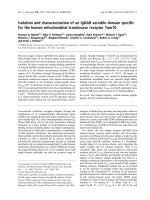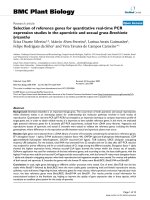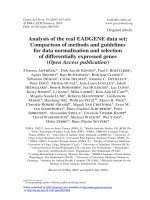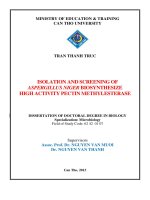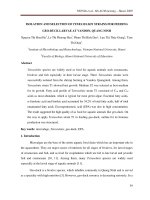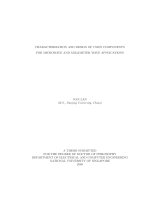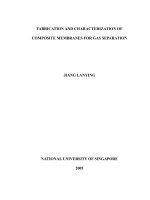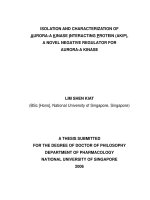ISOLATION AND SELECTION OF TETRASELMIS STRAINS FOR FEEDING GEO-DUCK LARVAE AT VANDON, QUANG NINH
Bạn đang xem bản rút gọn của tài liệu. Xem và tải ngay bản đầy đủ của tài liệu tại đây (427.74 KB, 9 trang )
NTH Ha et al., 6th ACM meeting – Hanoi 2009
39
ISOLATION AND SELECTION OF TETRASELMIS STRAINS FOR FEEDING
GEO-DUCK LARVAE AT VANDON, QUANG NINH
Nguyen Thi Hoai Ha
1
, Le Thi Phuong Hoa
2
, Pham Thi Bich Dao
1
, Lưu Thị Thùy Giang
1
, Tran
Thi Diep
1
.
1
Institute of Microbiology and Biotechnology, Vietnam National University, Hanoi
2
Faculty of Biology, Hanoi National University of Education
Abstract
Tetraselmis species are widely used as food for aquatic animals such crustaceans,
bivalves and fish especially in their larvae stage. Three Tetraselmis strains were
successfully isolated from the shrimp farming at Vandon, Quangninh. Among them,
Tetraselmis strain T1 showed best growth. Medium f/2 was selected as best medium
for its growth. Fatty acid profile of Tetraselmis strain T1 consisted of C
16
and C
18
acids as most abundant, which is typical for most green algae. Essential fatty acids,
-linolenic acid and linoleic acid accounted for 34.2% of total fatty acids, half of total
unsaturated fatty acids. Eicosapentaenoic acid (EPA) was also in high concentration.
The result suggested the high quality of as food for aquatic animals like geo-duck. On
the way to apply Tetraselmis strain T1 in feeding geo-duck, outline for its biomass
production was structured.
Key words: microalage, Tetraselmis, geo-duck, EPA.
1. Introduction
Microalgae are the base of the entire aquatic food chain which has an important role in
the aquaculture. They are major source of nutrients for all stages of bivalves, for larval stages
of crustaceans and fish, and as food for zooplankton which are fed to late larval and juvenile
fish and crustaceans [10, 11]. Among them, many Tetraselmis species are widely used
especially at the larval stage of aquatic animals [11].
Geo-duck is a bivalve species, which inhabits commonly in Quang Ninh and is served
as a specialty with high nutrition [3]. However, geo-duck resource is decreasing seriously. In a
NTH Ha et al., 6th ACM meeting – Hanoi 2009
40
way to find suitable food for sustainable development and conservation of this resource we
carried out the research “Isolation and selection of Tetraselmis strains for feeding Geo-Duck
larvae at Vandon, Quangninh”.
2. Materials and methods
2.1. Isolation and classification of Tetraselmis strains
Seawater was collected from the shrimp farming at Vandon, Quangninh. Tetraselmis
strains were isolated based on their morphological properties using micropipettes [5,9]. Algal
strains were grown at room temperature and illuminated under neon light (Philips daylight
tubes) on 10: 14 h light: dark cycles.
2.2. Selection conditions and nutrition component analysis
Media f/2 [5, 13], ASW (artificial sea water) and ESM (modified Erd-Schreiber's and
Schreiber's medium) were used to select culture medium for the growth and development of
each strain. Cells were cultured in 250-ml conical flask and harvested every two days. Cell
density was determined with a Neubauer haemocytometer in three replicates. In order to
survey the influence of temperature on photosynthetic system of Tetraselmis strains,
florescence indexes were measured using Plant Efficiency Analyser (PEA), Hansatech
Intruments Ltd., Englanh, from which Fv/Fm ratio was calculated [1,2].
Fatty acid composition was determined according to Krienitz et al. [8] by gas
chromatography (Finnigan Trace GC) using an ultra-column BPX70. Fatty acids were
identified by comparing retention times with those of a calibration standard solution.
3. Results and discussion
3.1. Isolation of Tetraselmis strains
Tetraselmis strains were isolated from the seawater at the shrimp farming in Vandon,
Quangninh and signified as T1, T2, T3. They were grown in non-aerated f/2 medium. Cell
density was determined every 2 days until 6 days of cultivation. Data were shown in Figure 1.
Among selected Tetraselmis species, T1 showed best growth, especially at 6-day culture and
would be used in following experiments.
NTH Ha et al., 6th ACM meeting – Hanoi 2009
41
0
20
40
60
80
100
120
T1 T2 T3
Time (days)
Cell density (x104/ml)
culture day 2
culture day 4
culture day 6
Figure 1. The growth of three Tetraselmis strains T1, T2, T3
3.2. Taxanomic properties of Tetraselmis T1 species
Observation on the morphology of Tetraselmis T1 species (Fig. 2) showed Tetraselmis
cells are usually solitary, free-swimming, thecate cells with four flagella and approximately
12-20 micrometers long. The four flagella are slightly shorter than the cell body. Each cell
contains a single pyrenoid, located more or less in the middle of the cell.
Division: Prasinophyta
Class: Prasinophyceae
Order: Dunalliellales
Family: Polyblepharidaceae
Genus: Tetraselmis
Figure 2. Morphology of
Tetraselmis strain T1
3.3. Selection of culture medium
Tetraselmis strains are photoautotrophic microorganisms. However, the biophysical
properties of microalgae may vary with respect to the alteration of environment [10,11].
Therefore, the selection of suitable culture medium is essential for the optimal development of
the microalgae. In this study, f/2, ESM and ASW medium were used for Tetraselmis strain T1.
NTH Ha et al., 6th ACM meeting – Hanoi 2009
42
Table 1. Cell density of Tetraselmis
T1 grown on different media
Culture
time
(days)
Cell density (10
4
/ ml)
f/2
medium
ESM
medium
ASW
medium
0
12,5
12,5
12,5
2
44
37,5
22
4
75
75
31
6
100
87,5
12,5
8
122
115
6,3
10
100
107
0
12
89
87
0
12.5
44
75
100
122
100
89
12.5
37.5
75
87.5
115
107
87
12.5
22
31
12.5
6.3
0
0
0
20
40
60
80
100
120
140
0 2 4 6 8 10 12
Time (days)
Cell density (x10
4
cell/ml)
F/2 medium
ESM medium
ASW medium
Figure 3. The growth of Tetraselmis T1 on
different media
Data showed the population density of Tetraselmis T1 increase steadily on f/2 medium
and reach the maximum (122x10
4
cells/ml) on the eighth day of culture. In the meantime, the
value was lower in case of ESM medium and much lower for ASW medium (Table 1, Fig. 3).
It is suggested that f/2 is the most suitable for culturing Tetraselmis strain T1 and can be
applied for biomass production in aquaculture.
3.4. The effect of temperature on photosystem II of Tetraselmis T1
Temperature has effects on the structure and function of photosystems in microalgae
and higher plants, thereby on the photosynthesis productivity and their growth. In this study,
we investigated the change of Fv/Fm ratio according to the temperature (Fig. 4).
The data suggested low heat-tolerance ability of Tetraselmis T1. Fv/Fm ratio was
reduced immediately when the temperature increased 1
o
C and more seriously when it is over
34
o
C and especially 40
o
C. However, Tetraselmis T1 microalgae grown on f/2 medium seemed
to be most stable.
NTH Ha et al., 6th ACM meeting – Hanoi 2009
43
0
0.1
0.2
0.3
0.4
0.5
0.6
0.7
0.8
25 26 28 30 32 34 36 38 40 42 44 46
Temperature (oC)
Fv/Fm
F2
ESM
ASW
Figure 4. Variation of Fv/Fm ratio related to temperature on different media
3.5. Analysis of fatty acid components of Tetraselmis T1
Lipid has its own specificity in each species of living organisms. Fatty acids are mostly
located in the cell membrane, which is much enough to apply to taxonomic characterization.
Furthermore, most animals cannot synthesize essential fatty acids (linoleic and linolenic acid)
thus have to depend on the diet [4,6]. Fatty acid components of Tetraselmis strain T1 were
analysed.
The fatty acid profile of Tetraselmis strain T1 (Table 2) consisted of huge range of fatty
acids from 12C to 23C with C
16
and C
18
being most abundant. This distribution is typical of
most green algae [6, 10]. The unsaturated fatty acids accounted for 68.5%, among which C
18
polyunsaturated fatty acids (PUFA) were the major.
Alpha-linolenic acid was found in highest concentration (27.1%) and higher Tetraselmis
sp. (-linolenic acid 16.7%) which have been reported by Pratoomyot [7]. Linoleic acid and -
linoleic acid are essential fatty acids that can be converted into long-chain PUFA in algae, which
many marine animals showed limited ability [8]. Furthermore, oleic acid and eicosapentaenoic
acid (EPA) have remarkably high content 13.2% and 9.3%, respectively which was comparable to
previous reports for which was comparable to previous reports for T. suecica with small amount of
NTH Ha et al., 6th ACM meeting – Hanoi 2009
44
EPA (4.5%)[15]. EPA of the membrane phospholipids is a precursor in prostaglandin synthesis,
which leads to synthesis of a number of other tissue hormones [6,8]. However, this microalgae
was deficient of DHA which was similar to T. chui and T. suecica but contrasts to Tetraselmis spp.
[7]. This result suggested high quality of Tetraselmis T1, which can be applied in aquatic food
webs such as for feeding geo-duck.
Table 2. Percentage composition of fatty acids in Tetraselmis strain T1
Fatty acids
Quantities (%)
C12:0
Lauric Acid
0.8
C15:0
Pentadecanoic Acid
1.9
C16:0
Palmitic Acid
10.8
C16:1
Palmitoleic Acid
1.0
C17:0
Heptadecanoic Acid
0.8
C17:1
Heptadecenoic Acid
0.3
C18:0
Stearic Acid
0.6
C18:1
Oleic Acid
13.2
C:18:2 n6
Linoleic Acid
7.1
C:18:3 n3
-linolenic Acid
27.1
C:20:1
Eicosenoic Acid
2.1
C:20:2 n6
Eicosadienoic Acid
6.1
C:20:4 n6
Arachidonic acid (ARA or AA)
0.4
C:20:5 n3
Eicosapentaenoic Acid (EPA)
9.3
C:22:2
Docosadienoic Acid
0.9
C:22:6 n3
DocosahexaenoicAcid (DHA)
0
C:23
Tricosanoic Acid
0.9
NTH Ha et al., 6th ACM meeting – Hanoi 2009
45
3.6. Biomass collecting of Tetraselmis strain T1
In order to collect biomass from Tetraselmis strain T1 for feeding geoduck larvae 8
day age, Tetraselmis strain T1 was cultured in f/2 medium, grown at room temperature and
illuminated under neon light (Philips daylight tubes) 4000 - 5000 Lux as the following scheme
with illustrated pictures.
Microalgae volume was used depending on geo-duck larvae density in the container. At Van
Don, Quang Ninh, we have been fed geoduck larvae with 120 – 180 liters microalage with cell
density 12.2-12.5 10
5
cells/ml for one tank about 2.510
5
– 16.610
5
geo duck larvae/m
3
per
day .
Stock culture
Cell density 2.25-3.310
5
cells/ml
2-6 litre flask
After 5-7 days, cell density
5,610
5
cells/ml
30–60 litre plastic bag
Cell density 8.8- 12.2 10
5
cells/ml after 4-6 days
160 litre tank
After 4-6 days, cell density
12.2 – 12.5 10
5
cells/ml
10 litre container
After 2-3 days, cell density
8.5-1110
5
cells/ml
NTH Ha et al., 6th ACM meeting – Hanoi 2009
46
4. Conclusions
Three Tetraselmis strains were successfully isolated from the shrimp farming at
Vandon, Quangninh and annotated as T1, T2, T3. Among them, Tetraselmis strain T1 showed
best growth and well cultured in f/2 medium.
Fatty acid composition of Tetraselmis strain T1 was typical of most green algae with
high content of C
16
and C
18
acids. Approximately 68.5% of total fatty acids were unsaturated,
among which -linolenic acid and linoleic acid were major components. There was also high
content of EPA (9.3%), a precursor in prostaglandin synthesis. The data suggested the
signification of using Tetraselmis strain T1 in feeding geo- duck as high quality food. The
outline of biomass production of Tetraselmis strain T1 for aquaculture of geo-duck larvae in
Van Don, Quang Ninh was established.
Acknowledgements
The authors wish to thank the Asia Research Center, Vietnam National University, Hanoi for
suport. Many thanks also to go the Center of Aquaculture Breeding farm, Vandon district for
supplying marine microalgae.
References
1. Dang Dinh Kim, Dang Hoang Phuoc Hien. Microalgae biotechnology, (1999),
Agricultural publishing house, 203.
2. EW Becker (1995) "Biotechnology and Algae", Cambridge University Press.
3. Ha Duc Thang, Ha Dinh Thuy. Producing techniques of Geo-Duck. Ministry of
Aquiculture.
4. I A Guschina, J. L. Harwood. Lipids and lipid metabolism in eukaryotic algae.
Progress in Lipid Research, Vol. 45, (2006), pp. 160–186.
5. JD Wehr and R. G. Sheath. Freshwater of North America: Ecology and classification.
2003. Elsevier Inc.
NTH Ha et al., 6th ACM meeting – Hanoi 2009
47
6. JK Volkman, S. W. Jeffrey, P. D. Nichols, G. I. Rogers and C. D. Garland. Fatty acid
and lipid composition of 10 species of microalgae used in mariculture. Journal of
Experimental Marine Biology and Ecology, Vol. 128, (1989), pp. 219-240.
7. J Pratoomyot, , Srivilas, P. and Noiraksar, T. Fatty acids composition of 10 microalgal
species Songklanakarin J. Sci. Technol., 2005, pp : 1179-1187
8. L Krienitz, M. Wirth. The high content of polyunsaturated fatty acids in
Nannochloropsis limnetica (Eustigmatophyceae) and its implication for food web
interactions, freshwater aquaculture and biotechnology. Limnologica, Vol. 36, (2006),
pp. 204–210.
9. LK Medline and I. Kaczmarska. Evolution of the diatoms: V. Morphological and
cytological support for the major clades and a taxonomic revision. Phycologia, Vol. 43
(3), (2004), 245-270
10. M. Piorreck, K. H. Baasch and P. Pohl. Biomass production, total protein,
chlorophylis, lipids and fatty acids of freshwater green and blue-green algae under
different nitrogen regimes. Phytochemistry, Vol. 23, No. 2, (1984), pp. 207-216.
11. N. De Pauw, G. Personne. Micro-algae for aquaculture. In MA Borowitzka, JL
Borowitzka, eds, Microalgal Biotechnology, (1988) Cambridge University,
Cambridge, MA, USA, pp 197–221.
12. R.R.L.Guillard, J.H. Ryther, Studies of marine planktonic diatoms. I. Cyclotella nana
Hustedt and Detonula confervacea Cleve. Can. J. Microbiol. 1962.pp 229-239.
13. R.R.L. Guillard, Culture of phytoplankton for feeding marine invertebrates In Smith
W.L. and Chanley M.H (Eds.) Culture of Marine Invertebrate Animals. Plenum Press,
New York, USA. 1975. pp 26-60.
14. S.S. An, T. Friedl, E. Hegewald, “Phynogenetic relationships of Scenedesmus and
Scenedesmus–like coccoid green algae as inferred from ITS–2 rDNA sequence
comparisons”, Plant Biology, Vol. 1, No 4, (1999), pp. 418 – 428.
15. Volkman et al., 1991. Fatty acids from Microalgae of the genus Pavlova. Phytochem.,
pp: 1855-1859.


